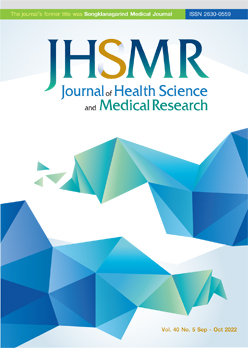An Early Hearing Detection and Intervention Program in Songklanagarind Hospital
DOI:
https://doi.org/10.31584/jhsmr.2022867Keywords:
ABR, early detection, early intervention, hearing, infant, neonatal screening, OAEAbstract
Objective: To compare the results of the universal newborn hearing screening program in Songklanagarind Hospital with the Joint Committee of Infant Hearing (JCIH) recommendations in regards to early hearing detection and intervention.
Material and Methods: We retrospectively reviewed the Early Hearing Detection and Intervention (EHDI) program results between January 2017 and June 2017. Furthermore, we calculated and compared the percentages of hearing screening, diagnostic evaluation, and rehabilitation at 1, 3, and 6 months of age.
Results: A total of 1,579 (93.1%) newborns were screened for otoacoustic emissions (OAEs). One hundred and eight (6.8%) newborns showed abnormal OAE in the first phase, and 11 (0.7%) newborns failed the OAE retest before discharge and within 1 month of age. Ten newborns (90.9%) had a hearing loss diagnosis confirmed due to a complete audiologic evaluation before 3 months of age, and 100.0% of newborns with abnormal hearing were enrolled for intervention within 6 months of age. Among the 4 newborns with abnormal hearing, 3 of them had conductive hearing loss, and one had profound sensorineural hearing loss, receiving an intervention via cochlear implant. Following intervention, all newborns with hearing loss had improved their hearing ability, speech and language development.
Conclusion: The universal newborn hearing-screening program is the first step in identifying a child with hearing problems, which leads into early intervention. The key to achieve best outcomes for the newborns is to ensure family support and the involvement of an interdisciplinary team.
References
White KR. The current status of EHDI programs in the United States. Ment Retard and Dev Disabil Res Rev 2003;9:79-88.
Keren R, Helfand M, Homer C, McPhillips H, Lieu TA. Projected cost-effectiveness of statewide universal newborn hearing screening. Pediatrics 2002;110:855-64.
Kemp AA, Delecrode CR, Silva GC, Martins F, Frizzo AC, Cardoso AC. Neonatal hearing screening in a low-risk maternity in São Paulo state. Braz J Otorhinolaryngol 2015;81:505-13.
Luz I, Ribas A, Kozlowski L, Willig M, Berberian AP. Newborn Hearing screening in a public maternity ward in Curitiba, Brazil: determining factors for not retesting. Int Arch Otorhinolaryngol 2016;20:300-4.
Connolly JL, Carron JD, Roark SD. Universal newborn hearing screening: are we achieving the Joint Committee on Infant Hearing (JCIH) objectives? Laryngoscope 2005;115:232-6.
Year 2007 position statement: principles and guidelines for early hearing detection and intervention programs. Pediatrics 2007;120:898-921.
Unlu I, Guclu E, Yaman H. When should automatic Auditory Brainstem Response test be used for newborn hearing screening? Auris Nasus Larynx 2015;42:199-202.
Colella-Santos MF, Hein TA, de Souza GL, do Amaral MI, Casali RL. Newborn hearing screening and early diagnostic in the NICU. Biomed Res Int 2014:845308.
White KR, Forsman I, Eichwald J, Munoz K. The evolution of early hearing detection and intervention programs in the United States. Semin Perinatol 2010;34:170-9.
Suppiej A, Rizzardi E, Zanardo V, Franzoi M, Ermani M, Orzan E. Reliability of hearing screening in high-risk neonates: comparative study of otoacoustic emission, automated and conventional auditory brainstem response. Clin Neurophysiol 2007;118:869-76.
Srisuparp P, Gleebbur R, Ngerncham S, Chonpracha J, Singkampong J. High-risk neonatal hearing screening program using automated screening device performed by trained nursing personnel at Siriraj Hospital: yield and feasibility. J Med Assoc Thai 2005;88(Suppl 8):S176-82.
Atipas S CC. Newborn hearing screening: overview. Siriraj Med J 2009;61:224-7.
Tungvachirakul V, Boonmee S, Nualmoosik T, Kamjohnjiraphun J, Siripala W, Sanghirun W, et al. Newborn hearing screening at Rajavithi hospital, Thailand: hearing loss in infants not admitting in intensive care unit. J Med Assoc Thai 2011; 94(Suppl 2):S108-12.
Poonual W, Navacharoen N, Kangsanarak J, Namwongprom S. Risk factors for hearing loss in infants under universal hearing screening program in Northern Thailand. J Multidiscip Healthc 2015;9:1-5.
Ravi R, Gunjawate DR, Yerraguntla K, Lewis LE, Driscoll C, Rajashekhar B. Follow-up in newborn hearing screening - A systematic review. Int J Pediatr Otorhinolaryngol 2016;90: 29-36.
Benito-Orejas JI, Ramírez B, Morais D, Almaraz A, Fernández- Calvo JL. Comparison of two-step transient evoked otoacoustic emissions (TEOAE) and automated auditory brainstem response (AABR) for universal newborn hearing screening programs. Int J Pediatr Otorhinolaryngol 2008;72:1193-201.
Yoshinaga-Itano C, Gravel JS. The evidence for universal newborn hearing screening. Am J Audiol 2001;10:62-4.
Hunter LL, Davey CS, Kohtz A, Daly KA. Hearing screening and middle ear measures in American Indian infants and toddlers. Int J Pediatr Otorhinolaryngol 2007;71:1429-38.
Holster IL, Hoeve LJ, Wieringa MH, Willis-Lorrier RM, de Gier HH. Evaluation of hearing loss after failed neonatal hearing screening. J Pediatr 2009;155:646-50.
Liming BJ, Carter J, Cheng A, Choo D, Curotta J, Carvalho D, et al. International Pediatric Otolaryngology Group (IPOG) consensus recommendations: hearing loss in the pediatric patient. Int J Pediatr Otorhinolaryngol 2016;90:251-8.
Rosenfeld RM, Shin JJ, Schwartz SR, Coggins R, Gagnon L, Hackell JM, et al. Clinical practice guideline: otitis media with effusion (update). Otolaryngol Head Neck Surg 2016; 154(1 Suppl):S1-41.
Boone RT, Bower CM, Martin PF. Failed newborn hearing screens as presentation for otitis media with effusion in the newborn population. Int J Pediatr Otorhinolaryngol 2005;69: 393-7.
Dedhia K, Graham E, Park A. Hearing loss and failed newborn hearing screen. Clin Perinatol 2018;45:629-43.
Cavalcanti HG, Melo LP, Buarque LF, Guerra RO. Overview of newborn hearing screening programs in Brazilian maternity hospitals. Braz J Otorhinolaryngol 2014;80:346-53.
Downloads
Published
How to Cite
Issue
Section
License

This work is licensed under a Creative Commons Attribution-NonCommercial-NoDerivatives 4.0 International License.
























